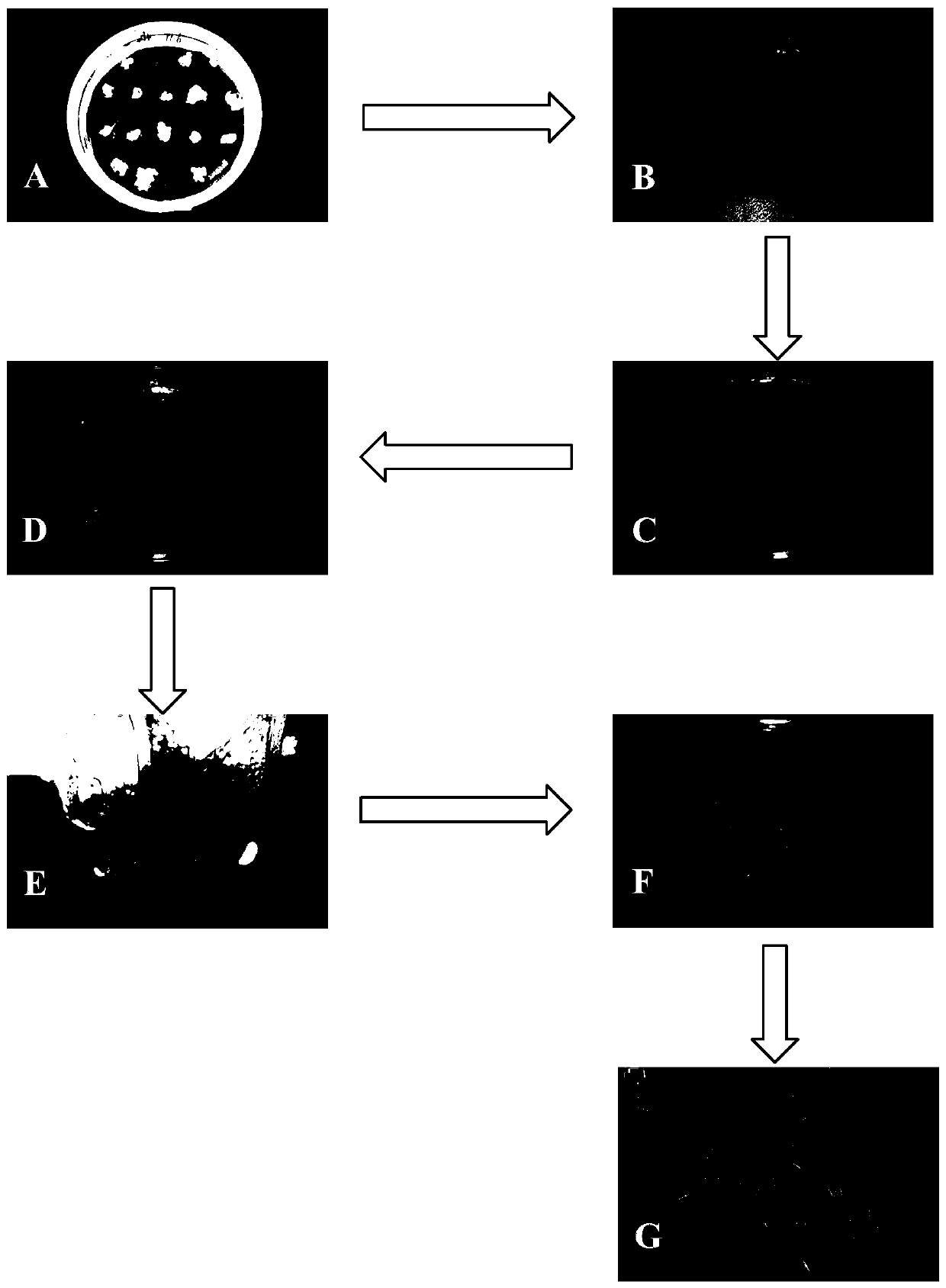Upland grass tissue-culture rapid propagation method for ecological restoration use
A tissue culture and ecological restoration technology, applied in horticultural methods, botanical equipment and methods, applications, etc., can solve the problems of low embryogenic callus acquisition rate, lack of tissue culture system for highland grass, and few creeping bentgrass.
- Summary
- Abstract
- Description
- Claims
- Application Information
AI Technical Summary
Problems solved by technology
Method used
Image
Examples
Embodiment 1
[0030] 1) The sterilized and sterilized seeds of creeping bentgrass are used as explants after vernalization, and first inoculated on the callus induction medium to induce callus
[0031] Explant selection and sterilization, vernalization
[0032] A. select the creeping bentgrass highland seed full of particles to be the tissue culture explant;
[0033] B. Soak for 2 minutes with 70% ethanol solution for the disinfection of the seed epidermis, and wash with distilled water for 3 times after disinfection to remove residual ethanol;
[0034] C. Soak in 70% sodium hypochlorite for 10 minutes, add 0.1ml Tween20, place on a magnetic stirrer for stirring, after sterilization, clean it with 500ml sterilized water on the ultra-clean workbench to remove residual sodium hypochlorite, then add 50ml sterile water Put it in a refrigerator at 4°C for low-temperature vernalization for 24 hours;
[0035] D. Put the vernalized seeds on the filter paper of the ultra-clean bench and blow dry. ...
Embodiment 2
[0052] 1) The sterilized and sterilized seeds of creeping bentgrass are used as explants after vernalization, and first inoculated on the callus induction medium to induce callus
[0053] Explant selection and sterilization, vernalization
[0054] A. Select creeping bentgrass highland seeds with full particles as tissue culture explants
[0055] B. Soak for 2 minutes with 70% ethanol solution for the disinfection of the seed epidermis, and wash with distilled water for 3 times after disinfection to remove residual ethanol;
[0056] C. Soak in 70% sodium hypochlorite for 10 minutes, add 0.1ml Tween20, place on a magnetic stirrer for stirring, after sterilization, clean it with 500ml sterilized water on the ultra-clean workbench to remove residual sodium hypochlorite, then add 50ml sterile water Put it in a refrigerator at 4°C for low-temperature vernalization for 24 hours;
[0057] D. put the vernalized seeds on the filter paper of the ultra-clean workbench and blow dry;
[...
Embodiment 3
[0075] 1) The sterilized and sterilized seeds of creeping bentgrass are used as explants after vernalization, and first inoculated on the callus induction medium to induce callus
[0076] Explant selection and sterilization, vernalization
[0077] A. select the creeping bentgrass highland seed full of particles to be the tissue culture explant;
[0078] B. Soak for 2 minutes with 70% ethanol solution for the disinfection of the seed epidermis, and wash with distilled water for 3 times after disinfection to remove residual ethanol;
[0079] C. Soak in 60% sodium hypochlorite for 10 minutes, add 0.1ml Tween 20, place on a magnetic stirrer for stirring, after sterilization, clean it with 500ml sterilized water on the ultra-clean workbench to remove residual sodium hypochlorite, then add 50ml Sterile water was placed in a 4°C refrigerator for low-temperature vernalization for 24 hours;
[0080] D. put the vernalized seeds on the filter paper of the ultra-clean workbench and blow...
PUM
 Login to View More
Login to View More Abstract
Description
Claims
Application Information
 Login to View More
Login to View More - R&D
- Intellectual Property
- Life Sciences
- Materials
- Tech Scout
- Unparalleled Data Quality
- Higher Quality Content
- 60% Fewer Hallucinations
Browse by: Latest US Patents, China's latest patents, Technical Efficacy Thesaurus, Application Domain, Technology Topic, Popular Technical Reports.
© 2025 PatSnap. All rights reserved.Legal|Privacy policy|Modern Slavery Act Transparency Statement|Sitemap|About US| Contact US: help@patsnap.com

